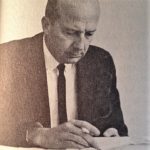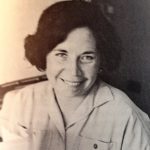Peru’s First Peace Corps Staff (Part Three)
After two years at Utah State, Darwin Bell enlisted in the Army as a private. It was 1942 and, like Frank Mankiewicz, he was sent to ASTP and—to continue the parallel—wound up a mortar gunner in the battle for France. Here their paths diverged.
Bell was captured by Germans in the Battle of the Bulge and was taken to Stalag 9-B in Bad Orb. He escaped from the prison camp twice and was recaptured twice. The third time he escaped, the Germans caught him again, but thinking he was dead, left him in a field where he was picked up by nuns and taken to an infirmary.
A doctor told him he had appendicitis and that he would be back the next day to operate. But the next day, according to Bell, “U.S. tanks came rolling into town, and the war was over for me.”
He spent the next nine months in hospitals recovering from severe malnutrition and damaged coccyx, wound up in Bushnell General Hospital in Logan, where he received a medical discharge.
On to the University of Utah, he received his degree in business management in 1948. The next years, at the University of Chicago, he earned an M.A. in industrial relations. He want to work for the Studebaker Corporation.
In November 1954, Bell took an overseas job with the Foreign Operations Administration, which sent him to Teheran as a personnel officer. After 13 months, he resigned, but remained in Iran as business manager of Litchfield Whiting, and architectural engineering firm with business in the Middle East. The same firm brought him back to New York and was about to send him to Bangkok.
“At the same time,” Bell reported, “ICA wanted to send me to Latin America. I thought the matter over carefully, decided I would find more security with ICA and that I would go back into government service to stay.”
Assigned to Bolivia, he completed a tour as executive officer for ICA in La Paz, and was then rotated back to Washington and charged with the selection and placement of personnel for the Near East and South Asia.
In Bolivia, he had worked with Warren Wiggins and Jack Vaughn, “and because of my friendship with them, I followed the development of the Peace Corps very closely. I was very dubious about it from my own experience overseas. Still, I went through the Talent Search interviews in January, 1962, and in the midst of the interviews I began to think the Peace Crops might work after all. In fact, I was soon completely enthusiastic about it.”
Bell was working on the expected August 1 arrival of the first Volunteers when the July 18 “golpe” came off, and the Volunteers were delayed. Mangin was down in Arequipa checking out arrangements for what was to become the second densest (after Addis Ababa, Ethiopia) concentration of working Volunteers in the world. With things at a standstill in Lima, Bell was sent to Ecuador to help set up the office in Quito. It gradually developed that Bell’s administrative background came to be used regionally.
In October, 1962, he helped set up the office in Honduras. In November, Jamaica. He attended the Panama Conference of Peace Corps directors in January, 1963, then lingered to help set u the office in San Jose de Costa Rica. Back to Panama again, he helped set up the office in Panama City in April, and then on to Venezuela for some office re-organization in Caracas before returning to Lima.


No comments yet.
Add your comment